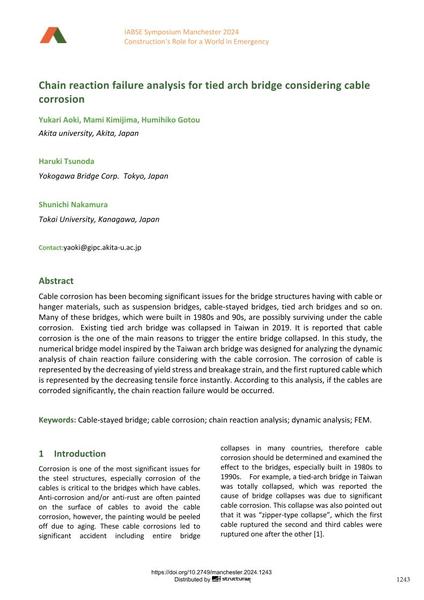Chain reaction failure analysis for tied arch bridge considering cable corrosion

|
|
|||||||||||
Détails bibliographiques
| Auteur(s): |
Yukari Aoki
(Akita university, Akita, Japan)
Mami Kimijima (Akita university, Akita, Japan) Humihiko Gotou (Akita university, Akita, Japan) Haruki Tsunoda (Yokogawa Bridge Corp. Tokyo, Japan) Shunichi Nakamura (Tokai University, Kanagawa, Japan) |
||||
|---|---|---|---|---|---|
| Médium: | papier de conférence | ||||
| Langue(s): | anglais | ||||
| Conférence: | IABSE Symposium: Construction’s Role for a World in Emergency, Manchester, United Kingdom, 10-14 April 2024 | ||||
| Publié dans: | IABSE Symposium Manchester 2024 | ||||
|
|||||
| Page(s): | 1243-1250 | ||||
| Nombre total de pages (du PDF): | 8 | ||||
| DOI: | 10.2749/manchester.2024.1243 | ||||
| Abstrait: |
Cable corrosion has been becoming significant issues for the bridge structures having with cable or hanger materials, such as suspension bridges, cable-stayed bridges, tied arch bridges and so on. Many of these bridges, which were built in 1980s and 90s, are possibly surviving under the cable corrosion. Existing tied arch bridge was collapsed in Taiwan in 2019. It is reported that cable corrosion is the one of the main reasons to trigger the entire bridge collapsed. In this study, the numerical bridge model inspired by the Taiwan arch bridge was designed for analyzing the dynamic analysis of chain reaction failure considering with the cable corrosion. The corrosion of cable is represented by the decreasing of yield stress and breakage strain, and the first ruptured cable which is represented by the decreasing tensile force instantly. According to this analysis, if the cables are corroded significantly, the chain reaction failure would be occurred. |
||||
| Mots-clé: |
Pont à haubans
|
||||
